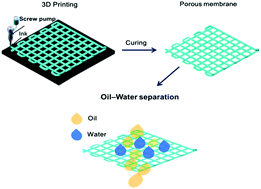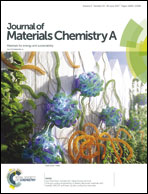3D printing of a mechanically durable superhydrophobic porous membrane for oil–water separation†
Abstract
Although superhydrophobic porous membranes are considered to be very promising candidates for oil–water separation, their fabrication methods often involve complicated treatments to build a coating with micro/nano-features on a porous mesh (called “coating on a mesh structure”), which can lead to weak mechanical stability of the superhydrophobic surfaces and the formation of inhomogeneous membrane pores. Herein, we report a facile and environmentally friendly 3D printing approach to fabricate superhydrophobic membranes with an ordered porous structure for oil–water separation using hydrophobic nanosilica-filled polydimethylsiloxane (PDMS) ink. The addition of nanosilica can improve the mechanical strength of the ink and thus ensures the formation of desired topographical structures without the risk of collapsing during 3D printing. Through adjusting the geometrical parameters, a superhydrophobic PDMS membrane was obtained, which mainly depended on the roughness at the sub-millimeter scale. More importantly, the 3D printing approach described herein integrated the superhydrophobic surface into the porous framework and resulted in a mechanically durable superhydrophobic membrane, which successfully avoids the weak interface adhesion issue that arises from the traditional “coating on a mesh structure.” Moreover, the pore size of the printed membrane could be easily adjusted via a computer program to optimize both the liquid flux and separation efficiency of the membranes. The maximum oil–water separation efficiency (∼99.6%) could be achieved for the printed porous membrane with the pore size of 0.37 mm, which also exhibited a high flux of ∼23 700 L m−2 h−1.



 Please wait while we load your content...
Please wait while we load your content...